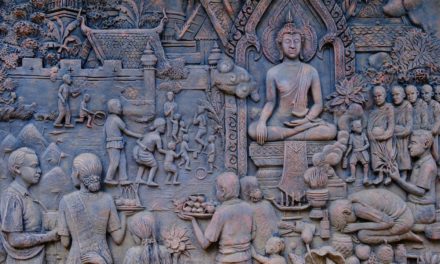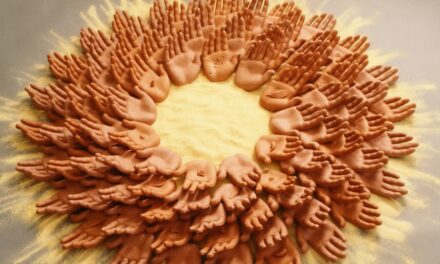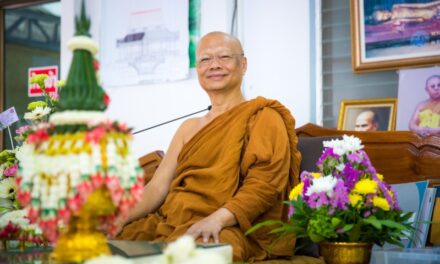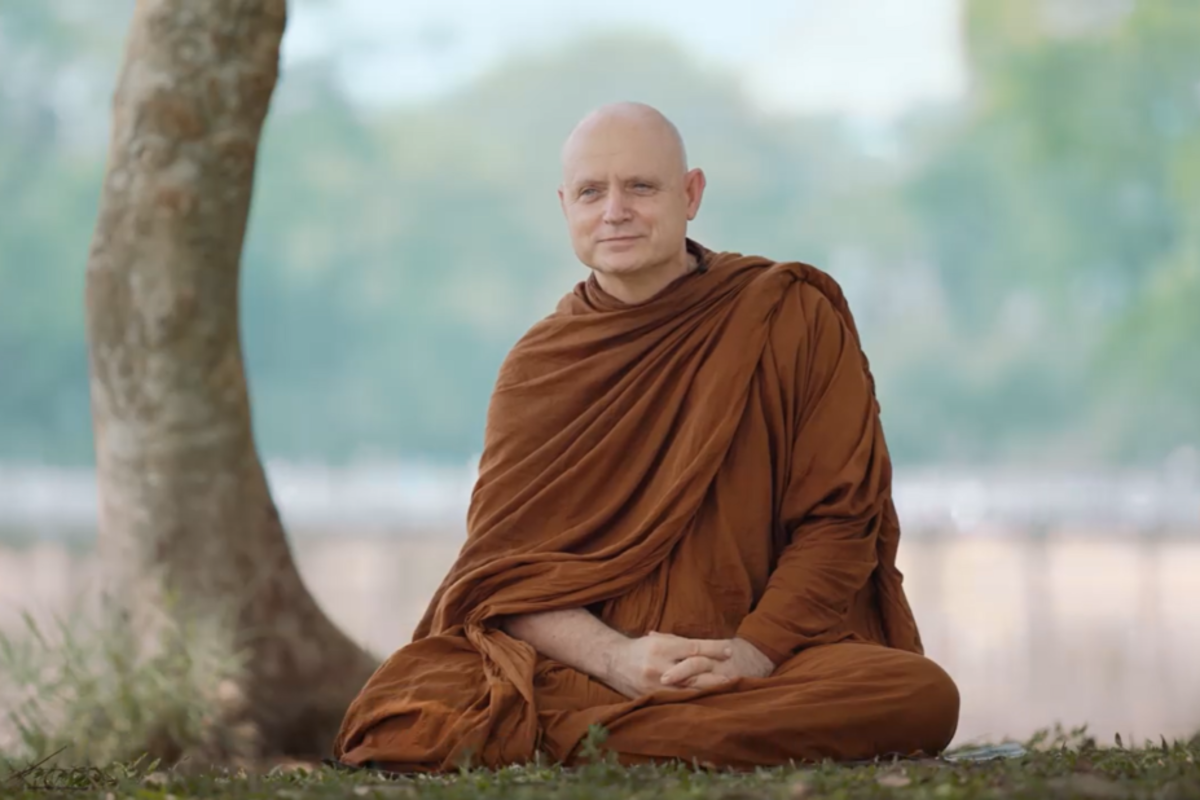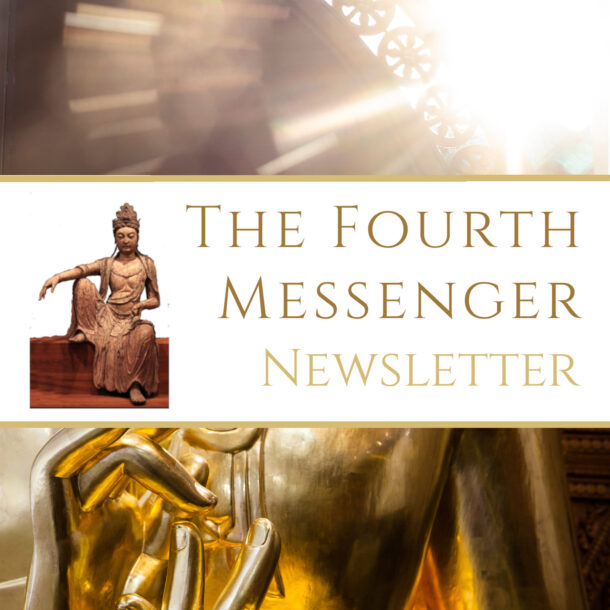Wandering & Study: Teachings from the Late Ven. Ñāṇadīpa’s Forty Years in the Forest
by Bhante Joe & Ven. Nisabho | Jan. 28, 2021
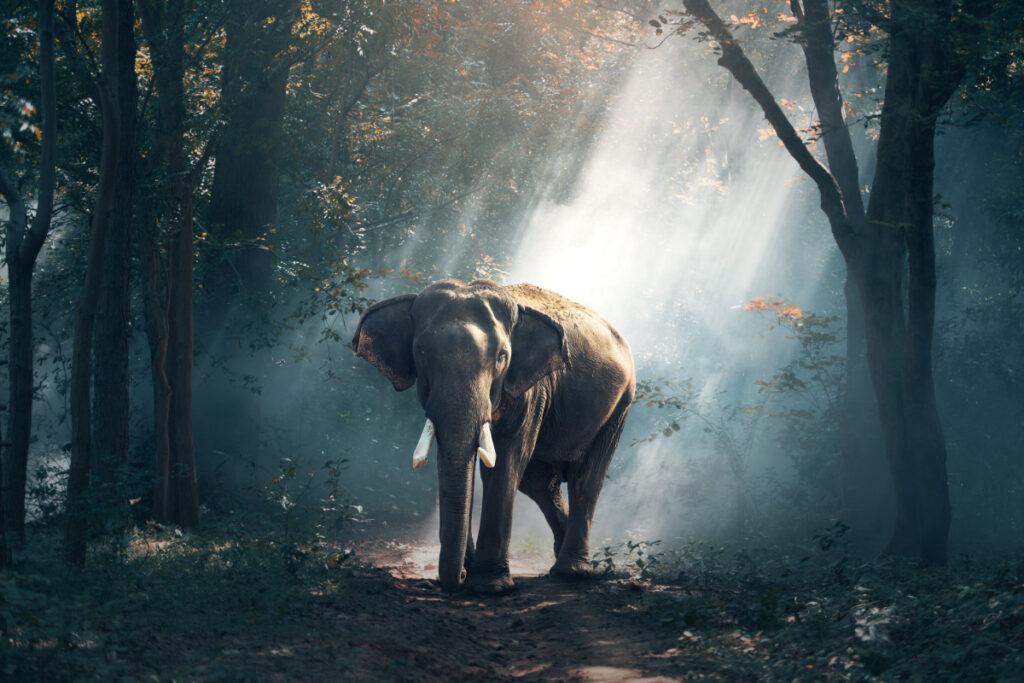
After being diagnosed with terminal cancer, the late Ven. Ñāṇadīpa gave up his customary forest wandering and spent the final months of his life sharing teachings on study, meditation, and the practicalities of forest dwelling gained from over forty years of living in Sri Lanka’s jungle. He passed away in September of 2020 renowned for the purity of a life of seclusion and practice.
The teachings below are drawn from “To the End of Body and Mind: The Story of Ñāṇadīpa Bhante’s Life and Teachings at Bhaddeka Vihari Aranya” which may be downloaded in full here. Another biography, “The Island Within: The Life of the Hermit Monk Bhante Ñāṇadīpa” may be found here. A talk detailing his life can be accessed here.
Read the companion piece, “Forty Years in the Forest: Teachings from the Late Ven. Ñāṇadīpa on Meditation & Insight“.
Biography
Ñāṇadīpa Bhante was born in Lyon, France, in 1944 with the name Denys Jeune. His father, Eugene, had been a member of the French resistance, and had been captured and sent to a concentration camp. Towards the end of the conflict, he was put on a ship carrying prisoners of war. Five days before the end of World War II in Europe, the RAF bombed the ship and he was tragically killed.
While in the concentration camp, Eugene made a pact with a fellow prisoner, Gregers Jensen. They agreed that if Eugene didn’t make it through the war, Gregers would help to care for his two young sons. When the war ended, Gregers sought out Eugene’s family. He met his widow, Renée, and they married. He was able to care for Eugene’s family, thus fulfilling his promise to his old wartime friend.
The family moved to Denmark. Denys received a classical education, studying Greek and Latin. As a teenager, he developed an interest in Mahāyāna Buddhism. He thought that he would like to be an academic. In University, Denys decided to major in Tibetan and Chinese.
Denys’s university career was not to be. An interest in travel drove him out of Denmark and onto three trips across Europe and Asia. When he was twenty-four, he arrived in Sri Lanka.
There, Denys began to read the Pāli canon which he soon realized contained the original words of the Buddha. Inspired, he converted to the Theravada.
In 1968, Denys ordained as an white-robed monastic aspirant at the Island Hermitage. He left for a short trip back to Europe but returned in 1969 to ordain as a sāmaṇera, or novice monk. He was given the name Ñāṇadīpa, which translates as ‘island of wisdom’. Not long after his ordination, Venerable Ñāṇasumana, who was a fellow Island Hermitage monk, invited Sāmaṇera Ñāṇadīpa to stay near the solitary Buṇḍala Kuṭi.
Sāmaṇera Ñāṇadīpa accepted the invitation and went to stay in the Buṇḍala forest. At night, he would make a pile of leaves and spread his robe over them, spending the night on this makeshift mattress. This can perhaps be seen as the beginning of what would become a lifetime of forest dwelling.
Ven. Ñāṇasumana stayed inside the Buṇḍala Kuṭi. He and Sāmaṇera Ñāṇadīpa would meet for a shared alms round and discuss the Dhamma after the morning meal. Unfortunately, Ven. Ñāṇasumana was killed by a snake, leaving Sāmaṇera Ñāṇadīpa as the sole inhabitant of the Buṇḍala Kuṭi.
In 1971, Sāmaṇera Ñāṇadīpa took higher ordination and became Ñāṇadīpa Bhante. Soon after, he returned to the solitude of the Buṇḍala Kuṭi. Apart from a short trip to Thailand, he would spend most of his life dwelling in the solitude of Sri Lanka’s forests.
In 1984, Ñāṇadīpa Bhante arrived in the Laggala forest where the villagers built him a solitary kuṭi. Bhante stayed in the Laggala area for fifteen years. Almost every year, he built a new kuṭi. Gradually, other monks joined him and a community began to form its culture spreading out from Laggala and strongly influencing the Sri Lankan forest tradition.
In his later life, Ñāṇadīpa Bhante spent more time at monasteries, his increased engagement with other monks allowing his knowledge to spread. He passed away in September of 2020 at Etdalagala monastery. By the time of his passing, he had become something of a legend. He left behind a legacy of solitary forest practice that continues to this day and an example of a life devoted to finding the end of suffering.
Ven. Ñāṇadīpa’s Reflections
on
Forest Wandering
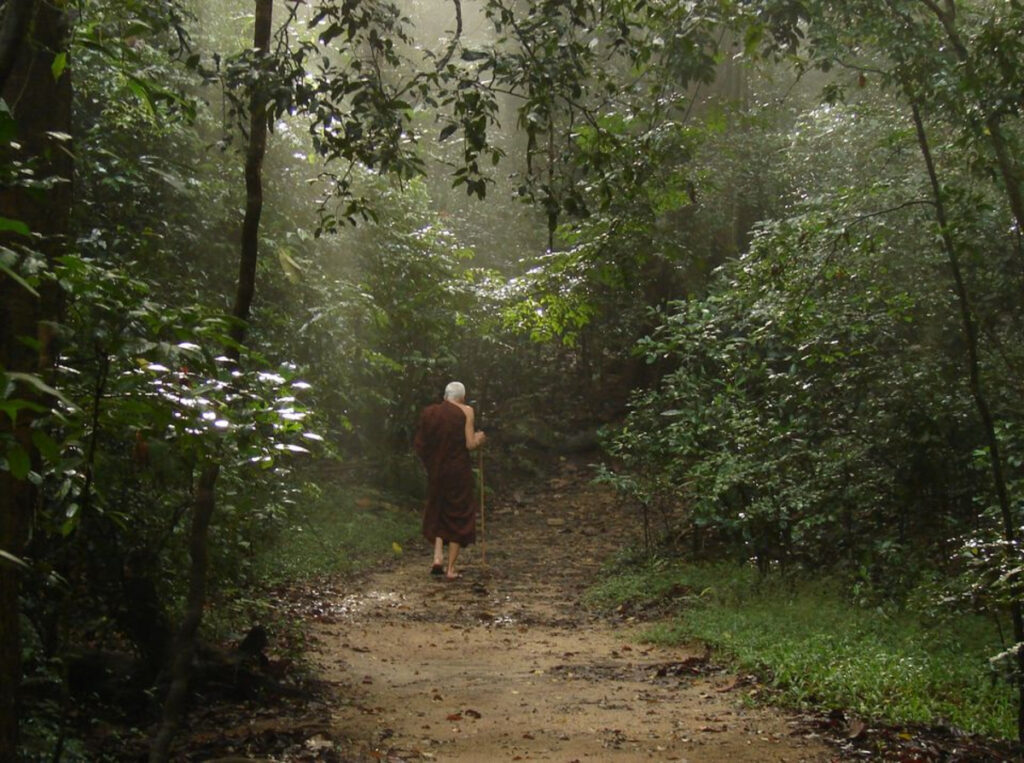
Ven. Ñāṇadīpa was known for living alone in three-walled jungle kutis, particularly in an isolated region of Sri Lanka called Laggala.
Living Alone
“The greatest danger in living alone is losing delight in the Dhamma.”
* * *
“When one goes to stay [alone] in the forest, fear of external danger is not the biggest problem. The biggest problem is the kilesas (defilements) that come up in one’s mind (…). When you’re living alone, you can’t (go talk to someone). So, that’s the real test, and it’s good to test oneself out in that way. But, if one finds that one can’t do it, then an aranya might be more suitable. It might be more suitable not to live on one’s own.”
* * *
“Living alone isn’t a one-way street. You can always go back if you want to.”
* * *
During one Dhamma discussion, after discussing living alone, Bhante suddenly leaned forward in his chair. Looking intently, he said: “One thing that I do want to emphasize, is that if one goes into solitude, then one shouldn’t take a computer or smartphone, because then, you’re not really alone. One needs to be alone with one’s body and mind. I never had a computer or a smartphone. They weren’t around in those days, and I never found that I needed one.”
* * *
Towards the end of his life, Bhante remarked: “Now that I’ve been living alone for so long, I can’t imagine a life without solitude.”
Staying in the Wilderness
Guttasīla Bhante: “Bhante would have a kuṭi built where there’s a good permanent water supply… there had to be good forest, there would be non-disturbance from any noise, from maybe aeroplanes. It would also be comfortable to stay there, that there would not be too many mosquitoes or biting creatures — all these things. He’d try a place. First of all, he might even stay there without any shelter. ‘Cause the dry season, when it doesn’t rain. So then, he might have… a temporary kuṭi built. But then, if the place was actually suitable, well then he’d have a more permanent kuṭi built. By permanent, I mean to say livable.”
* * *
Guttasīla Bhante: “You had to get support from piṇḍapāt (alsmround). So, he’d be going, maybe walking in the forest and staying some days until he found a suitable place, then going piṇḍapāta to the neighbouring village. All these villages are in the forest, connected with the forest. Not like modern times. And, the villagers, they had wonderful faith…. So, you get all these kind of connections, but then people had so much good faith that when they meet Bhante, they’re very impressed. So, then they want to build the kuṭi, provide support — it’s just his charisma and the way that he leads the monk’s life. So, you know, the men get so impressed to help… the village people to give dāna.”
* * *
Bhante would usually stay at a kuṭi for about a year, and then move on. In this way, many solitary kuṭis were built in Sri Lanka. Through his example, Bhante helped to build a culture of solitary forest meditation. This is now a culture for which Sri Lanka is becoming known. Bhante always had mud kuṭis built. Bhante remarked, “An aranya (forest) tradition already existed in Sri Lanka, but I am the founder of the mud kuṭi tradition.”
* * *
If all of one’s robes were to get wet in the rain, Bhante advised: “You can try to wring them out as much as possible. If there’s no sun, and it’s humid, then the only option is to put them on, and let the heat of the body dry them.”
Dealing with Wild Animals
“A nāga can mean any kind of great being. Elephants and some cobras can be considered nāgas. The arahant is the foremost type of nāga. When one recites the paritta (protective chant), the most important thing is to have a friendly attitude. Then, sometimes, the elephant will feel that and leave one alone.”
* * *
“Ñāṇavimala Bhante had that experience where he was staying at Kudumbigala, and the bear approached him with its claws extended. He chanted the Khandha Paritta, then the bear retracted its claws and left. I haven’t had experiences like that.
“The most important thing when chanting parittas is the frame of mind. One should have a mind of mettā (goodwill). One can use any words one wants, but the frame of mind is most important.”
* * *
When asked about snakes, Bhante replied: “For the most part, they’re not dangerous. I was bitten three times. The first two times, there was a little swelling. Often snakes will not release all of their venom. Juveniles can sometimes be more dangerous, because they don’t know how to control their venom.
“The third time, I was taking a bath. I was soaping up, and saw a snake coiled on the bank. There is a type of snake that’s capable of jumping. It jumped, and bit me on the thigh. I think it was angry because I was soaping up its hunting ground. It thought I might get rid of all the frogs.
“That time, my leg swelled a lot. I would fast every Saturday, and the following day was my fast day. So, I wouldn’t see the villagers until the day after. When I went for piṇḍapāta, a boy noticed my leg. They were quite concerned, but I wasn’t worried. I knew I would not die.”
* * *
“There’s a type of snake that can climb the walls of a mud kuṭi. It has a way of twisting its body and climbing up. These kuṭis (referring to a concrete kuṭi) they can’t climb. They climb the walls, and live in the rafters.
“Sometimes, I would be sitting in the kuṭi, and hear a sound like (smacks his hand against something nearby). A snake had fallen from the roof… One can get a broom and flick it outside. One need not worry about harming the snake. They have a way of twisting their body to soften the fall.”
* * *
A Canadian monk told Ñāṇadīpa Bhante about a close encounter with a cobra. He said he’d yelled loudly, and chanted the khandha paritta in a frightened voice. Bhante replied: “The main thing is to stay calm, and radiate feelings of calm towards it.”
* * *
Regarding crocodiles, Bhante said: “They don’t eat monks, so don’t worry… If one is bitten, it will want to drag you down into the water. In that case, one can grab both its nostrils to cut off the air flow. When it opens its mouth to breathe, then one can get away.”
* * *
“One needn’t worry so much about snakes. Elephants, on the other hand, one should be careful of.”
* * *
A few monks were planning to head on a trip into the wilderness outside of Tanjantenna. One monk asked Bhante what they should do if they encountered an elephant. Bhante replied: “You can make your way away from it. It’s best to go upslope. It’s hard for them to go up slopes. It’s easy for them to go down steep slopes, but they aren’t so good at climbing. So, if you can go up a slope, that will slow them down.”
* * *
“Sometimes the gāthā (in this case, a specific protective chant – “nāgassa nāgena…”) doesn’t work. Once, I recited the gāthā to an elephant, and he began to quickly come towards me. I started to head up the slope (to the top of a hill). There was another path to the top of the hill, and the elephant ran up that path to meet me. I continued along the side of the hill and then returned to the (original) path. When the elephant reached the top, it saw me (back on the original path), and quickly turned around. I jumped into a stream bed, and started to follow it down. The elephant did not follow me after that. He didn’t like my gāthā.”
* * *
“Once, I was walking in the forest, and I saw an elephant with a baby on the path ahead. So, I took a side path down into a stream. It knew I was going to the stream, and by the time I got there, it was already waiting for me. When I emerged from the bushes, the elephant was just twelve feet in front of me.
“It charged me, and in that case, I didn’t have time to react. So, I just stood with my arms like this (places arms at his side). There was nothing I could do. I looked into the elephant’s eyes, and the thought came up, ‘He’s bluffing.’
“The elephant crashed into the bushes to the side. Often, elephants don’t want to kill, they just want to see you run. They want to see you scared.”
* * *
Once, during a massage session, a Canadian monk asked Bhante about a trail he was thinking of exploring. The trail went between two mountains, and was in a flat and shady area of the forest. There were signs of frequent elephant use. He asked Bhante whether trails like this were safe to explore on one’s own or whether one should go with a group. Bhante replied: “In my case, I explored on my own… Don’t worry; you can explore it on your own.”
The monk continued asking questions about other wild animals. Eventually, Bhante said: “Why are you so concerned with safety?… Don’t be so concerned with safety.”
* * *
Regarding fear: “It’s important to have mettā for the various beings in the forest. One learns to recognize the fear coming up, but not be afraid of the fear itself.”
How to Go Wandering
“You can go into any forest in Sri Lanka… Don’t worry; just go there.”
* * *
“Here (in Sri Lanka), we don’t use the mosquito net and umbrella that they do in Thailand. They’re too heavy. You just sleep at the root of the tree…
“Sometimes, I would be heading back to my kuṭi, but wouldn’t make it before dark. So, I would have to find a tree. The tree should be on level ground. You can sleep there.”
* * *
A monk asked Bhante how to find springs in the forest. Bhante replied: “I spent so much time walking in the forest, that I became used to finding springs. Sometimes villagers would tell me, but for the most part, I would find them on my own.”
* * *
“When one goes to stay in a forest area, people may be suspicious. So, what one can do is to make sure that one is always practicing because they might spy on you. That happened to me. People came to spy on me. Because of this injury, they saw the way I was sitting in meditation, and they said ‘That’s not meditation’. So, one wants to make sure that one is always practicing, because otherwise people may become suspicious.”
* * *
An upāsaka (devoted lay follower) asked Bhante how long one should sleep each day. The upāsika said that in the suttas, it seemed to recommend four hours of sleep per night. Bhante replied, “Anywhere between three and five hours sleep is a good amount, but one shouldn’t try to force it. Six hours would be too much. But, if one is at the beginning of one’s practice, one shouldn’t worry too much if one is sleeping six hours. However, one shouldn’t be pleased with that.
“The amount of sleep needed can vary from person to person. One shouldn’t be dull; one shouldn’t be dreary in one’s meditation. Also, I take a nap in the middle of the day for one hour.”
* * *
One monk from the Thai tradition came to visit Bhante after he had moved to the Mahāthera Kuṭi. He asked Bhante about the importance of humour in the practice. Bhante replied: “Being able to laugh at oneself is important. Making jokes for fun is not important.”
* * *
During a massage session, one monk asked Bhante about a ‘crossroads’ period in a monk’s life. He said that at a certain point, a monk could go down one path, and possibly start their own monastery. They could also go down another path, and continue practicing for life. However, worries can arise: if one doesn’t have one’s own monastery, then others could take advantage of one, and stop one from following the monastic rules. To this, Bhante replied: “These things don’t happen.”
* * *
One monk asked how one could know if the ascetic practices were beneficial. Bhante replied: “You have to watch your mind. If one sees that they’re unbeneficial, then one should stop. These are external things; they’re meant to support internal development.”
* * *
When asked about having a sense of pride in ascetic practices, Bhante replied: “Pride comes from asmi māna (the conceit, “I am”); that’s the root defilement — a sense that I’m better, I’m worse, or I’m equal. In my own case, I usually felt that I was worse.”
* * *
Aamanera: “Did you ever go barefoot?”
Ñāṇadīpa Bhante: “I did for a little while, but it got quite difficult.”
Sāmaṇera: “What were the disadvantages?”
Ñāṇadīpa Bhante: “Well, the disadvantages are obvious.”
Ven. Ñāṇadīpa’s Reflections
on
Study
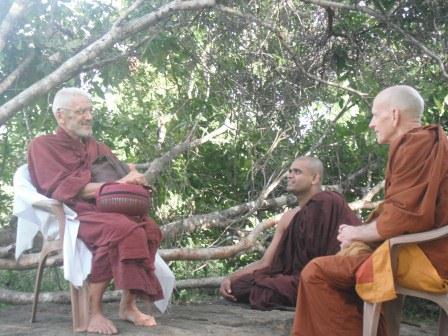
Venerable Ñāṇadīpa instructing visiting monks at Bhaddeka Vihari in 2010. In his later years, he spent much of his time sharing his experiences from a life of practice.
Suttas
When asked about how a monk should spend his time, Bhante replied: “It’s important to read the suttas, and best if one can read them in Pāli.”
* * *
Regarding the suttas, Bhante said: “Reading the suttas in Pāli is like listening to the Buddha himself.”
* * *
When one learns Pāli, sometimes one will be meditating and the meaning of a verse will become clear. That’s the difference between scholars and meditators.”
* * *
One monk asked about the authenticity of the Pāli canon. He related that there were some stories, especially in the Dīgha Nikāya, which seemed hard to grasp. Bhante confirmed that there were probably inauthentic suttas in the Pāli Canon. However, referring to some of the stories in the Canon, Bhante said: “One has to look for the Dhamma aspect of them. If one looks for the Dhamma aspect, then one is always safe.”
Concepts
“Nāma (name or mentality) includes vedana (feeling), saññā (perception), and saṅkhāra (formations), but not viññāna (consciousness). Viññāna is what’s aware. The commentaries include viññāna under name, but in the suttas, that’s not the case.”
* * *
An upāsaka (devoted lay follower) asked Bhante how to translate ‘papañca’. It is often translated as ‘proliferation’. Bhante replied: “I translated it as ‘expansion’. There are different kinds of papañca. One type is ‘kilesa papañca’; another is the papañca of the sense bases. One starts from the senses and expands from that to fill out all experience.
“Arahants are free of kilesa papañca, but even having six sense bases is a type of papañca. When an arahant attains parinibbāna (complete enlightenment upon the body’s death), that’s the end of papañca.”
(Bhante quoted a portion AN 4.173. An excerpt is reproduced below.)
[Ven. Mahā Koṭṭhita:] “Being asked if, with the remainderless fading & cessation of the six contact-media, there is anything else, you say, ‘Don’t say that, my friend.’ Being asked if… there is not anything else… there both is & is not anything else… there neither is nor is not anything else, you say, ‘Don’t say that, my friend.’ Now, how is the meaning of your words to be understood?”
[Ven. Sāriputta:] “The statement, ‘With the remainderless fading & cessation of the six contact-media, is it the case that there is anything else?’ objectifies the unobjectified. The statement, ‘… is it the case that there is not anything else… is it the case that there both is & is not anything else… is it the case that there neither is nor is not anything else?’ objectifies the unobjectified. However far the six contact-media go, that is how far objectification goes. However far objectification goes, that is how far the six contact-media go. With the remainderless fading & cessation of the six contact-media, there comes to be the cessation of objectification, the stilling of objectification.”
* * *
“Āsava can mean both inflow and outflow. ‘Taints’ is a word that gets used, but it’s not strong enough. It means something that penetrates, and pervades one’s whole being. It’s like a pollution; a very root defilement.
“It can also refer to the discharge from a sore. The āsavas overlap with the kilesas in some respects. Kāmāsava (the pollution of sensuality) and bhāvāsava (the pollution of becoming) are related to craving. Avijjāsava (the pollution of ignorance) is related to delusion.
“The āsavas are what make one a ‘being’.”
* * *
When asked if one should look at the khandhas (the “aggregates” of experience, namely form, feeling, perception, formations, and consciousness) sequentially, Bhante replied: “The khandhas don’t work sequentially in experience. When one sees a form and notices its shape, saññā (perception) is already operating. Saṇkhāras (mental formations) are what weaves everything (the experience) together.”
* * *
When asked whether saṅkhāras can be controlled, Bhante replied: “Yes, control is a saṅkhāra. You can use a saṅkhāra to control other saṅkhāras. But, the fact that all saṅkhāras are anicca, dukkha, and anatta — that, one can’t control. They are always anicca (impermanent).”
* * *
Monk: “Does dependent origination describe one life, or multiple lives? There are different ideas about it.”
Ñāṇadīpa Bhante: “It can be both. The suttas frequently reference more than one life. Obviously, there is birth (re-birth) in the dependent origination links. The links of contact, feeling, craving, clinging, and becoming are something that one can observe in this life.
“When one observes (dependent origination) in this life, when one sees it truly — not just philosophising, but observes it in one’s own experience — then one learns to make a true inference: this process applies not just to this life, but to other lives as well.
…Bhante quoted SN 12.33 (likely in Pāli, from memory). This sutta describes how a bhikkhu comes to gain insight into ageing and death. From this, he makes an inference that ascetics and brahmins in the past would have understood ageing and death in the same way he has. Likewise, with the future….
“One learns to make a true inference. One gains understanding, and it extends to all of samsāra.”
* * *
In some suttas, avijjā (ignorance) is given as the cause of suffering. In others, taṇhā (craving) is given as the cause of suffering. When asked about this, Bhante replied: “They’re describing the same thing. Asmi māna (the conceit ‘I am’) is a type of craving. One has that craving because of ignorance; because of not seeing things properly. Practically speaking, one will be working with craving the most, as it’s easier to see.”
* * *
In the Abhidhamma, consciousness is described as a series of discrete moments. One monk asked about this and Bhante replied: “It’s not so much a series of discrete moments, it also has a stream-like effect. The faculty of seeing, hearing, etc. can be more stream-like. There’s no need to get too philosophical. In your meditation, you don’t have to see these discrete moments of consciousness.”
* * *
There is always an element of name and form together with consciousness (in experience). They require each other to stand.”
* * *
Monk: “In dependent origination, it seems that the way rebirth takes place is that name and form and consciousness are dependent on one another. I’m confused as to why these things revolve around each other and cause rebirth.”
Ñāṇadīpa Bhante: “The suttas don’t use the word ‘revolve’. They’re dependent on each other. Venerable Sāriputta gives the simile of the two sheaves of reeds leaning against one another. There’s consciousness, which is the knowing aspect. There’s also name and form. Name includes the mental khandhas, except for consciousness. Name and form and consciousness cannot exist without one another. Like two sheaves of reeds, if you take one away, the other will fall. Consciousness cannot exist without an object. It comes into existence as a result of contact between an external object and an internal sense faculty.”
Consciousness
You don’t have to think of them (consciousness and name and form) as two separate things. In Pāli, they use the word, ‘bhūta’, which means what has come to be, and in our world of experience, what has come to be can be described as name and form together with consciousness.”
* * *
Name and form cannot be separated; that’s why it’s a compound word (nāma-rūpa).”
* * *
When asked about the difference between ‘mano’ (mind) and ‘vinññāna’ (consciousness), Ñāṇadīpa Bhante replied: “Mano can have a physical aspect. You need the brain for memory, and other parts of the body are involved as well, such as the spine. Mano is the base.
“Mano viññāna’ is the knowing of what they call ‘dhamma’. Mano viññāna pulls in the other five senses. It’s a special kind of consciousness that weaves together the consciousness of the other sense bases such as the eye, the ear and the nose (as well as the tongue and the body). It knows ‘dhammas’ (ideas), but it also has this aspect of unifying the five senses.”
* * *
Consciousness, space, earth, fire, water, and wind are dhātus (elements). Consciousness is a dhātu because it has a type of independent existence. Form has this element of resistance, in that it resists our efforts to change it. Consciousness has this element as well. It’s called a dhātu because it links together the past and the future. This is where memory is found. As long as there is craving and clinging, name and form are always conjoined with the consciousness dhātu.”
* * *
It’s not just consciousness which is involved in connecting memory to the past and the future, other saṅkhāras are involved as well. They’re all bound up in the process of creating memories.”
* * *
Monk: “What’s to stop someone from calling anidassana viññāna (“consciousness without feature”) a ‘self’?”
Ñāṇadīpa Bhante: “It can’t be called a ‘self’. When one is engaged in ‘I making’ and ‘my making’, one is attached to something that one is becoming now, has been in the past, or will be in the future. When one doesn’t have these attachments, it (anidassana viññāna) can’t be called a self. There’s really nothing that can be said about it at all.”
Note: Anidassana viññāna (“consciousness without feature”) is a form of consciousness mentioned in the suttas that differs from normal sense consciousness and is associated with enlightenment. An in-depth discussion may be found here.
* * *
The consciousness of all arahants is the same. The Buddha’s anidassana viññāna is the same as Venerable Māhamogallāna’s or Venerable Sāriputta’s. They’ve been rid of defilements to the same degree.”
* * *
It (anidassana viññāna) wouldn’t be a group consciousness. They are individual consciousnesses, but you can’t say they’re individual selves. They’re individual persons — ariyapuggalas (enlightened beings) — but they’re not selves.”

